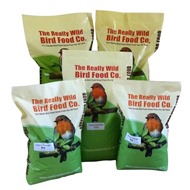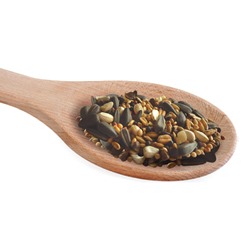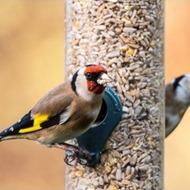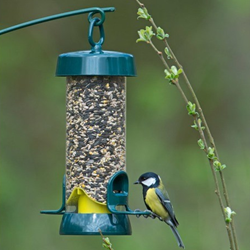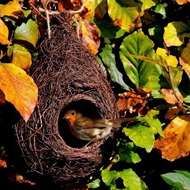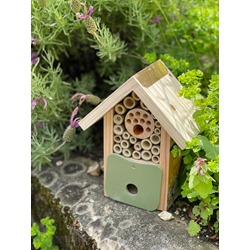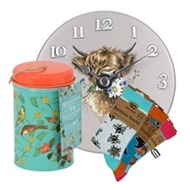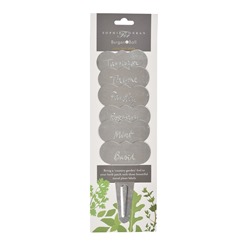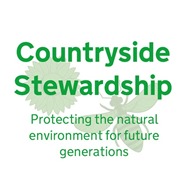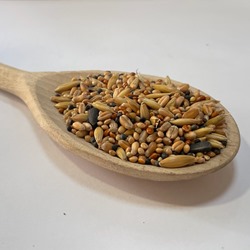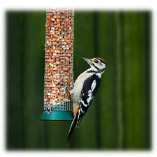
When Bird baths are an artificial pool or shallow basin filled with water, which is made for birds to bathe in, cool off and…unlike for humans!…drink the bath water. Bird baths provide a safe place for wild birds to bathe as birds require bathing to keep feathers clean and flexible and to maintain their skin healthy.
A bird bath provides a reliable source of water for birds and encourages wild birds into your garden.. in the summer to take bath and in the winter to drink ice free water. Hopefully the bird bath will be safe from predators.
A good looking bird bath makes a wonderful feature in any garden and draws a variety of entertaining birds to your garden.
Several types of bird baths are available in varies shapes and sizes and in different materials like the cast iron bird bath, stone bird bath, concrete bird bath and the plastic bird bath. At The Really Wild Bird Food company we provide a wide range of bird baths (link to http://www.reallywildbirdfood.co.uk/bird-baths-and-drinkers/garden-bird-baths-10-36/) to suit almost every requirement.
A good bird bath should be simple, and light enough to make it easy to clean and refill. The surface of the bath should be rough allowing birds to grip it with their claws without slipping.
Position your bird bath in your garden where a bird can easily see any predator and near to trees where a bird can survey the area before landing to use the bird bath.
To use it to attract birds to your garden, a bird bath must be kept full of clean water. Cleaning your bird bath every few days is essential to the health and safety of birds that use it. Also keep your bird bath free of unsightly stains and smells. The benefits of bird baths are well worth the effort it takes in keeping them clean, filled, placed safely and picking the right one.
More About Helping Birds Survive & Thrive
Helping garden birds to survive and thrive is about creating a garden that your birds and other wildlife can appreciate and enjoy all year round. Thriving bird populations are a sure sign that we are creating a healthy and sustainable living environment. What we offer in our gardens is so important because the total acreage of gardens in the UK is huge - it actually exceeds that of all UK Nature Reserves put together! There are lots of things we can do to support our wild birds. This article will focus on feeding garden birds.
The best way to provide the supplementary energy and nutrients which your garden birds rely on, and to maximise the number of different species of garden bird visiting your garden, is to provide a variety of high quality food types, offered in a range of different feeders, at a number of locations throughout your garden. Then there is something for everyone to eat and pure enjoyment for you as you support a thriving bird population right on your doorstep!
Garden birds do have preferences for where and how they feed. Birds such as Chaffinches, Robins, Dunnocks, Thrushes, Blackbirds and Wagtails really like to have their feet on the ground. However new innovations like simple perch rings for seed feeders, act as a platform for feeding birds and make it much easier for Robins and Chaffinches to scale the heady heights of hanging feeders! Clinging birds like the Tit family and Great Spotted Woodpecker love to hang on to a feeder and birds like Greenfinches and Sparrows are happiest perching. So offering different feeder types is a really good thing to do.
What food you offer will also, to some extent, be determined by, e.g. the season and the climate. During the breeding season, when birds are feeding young chicks, food which is high in protein, such as live mealworms and waxworms will be of most benefit to the young offspring. Adults will feed their young before they feed themselves, so if live foods are in short supply, the adults tend to offer these to the chicks and they will fall back on available seeds. Sunflower hearts are a really good choice in this situation, since they are high in oil and offer an immediately available source of energy because they don't require de-husking which takes up valuable time; maximum energy with minimum effort!
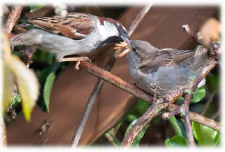 |
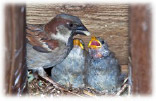 |
During the freezing winter days, where small birds like Blue Tits and Long Tailed Tits can spend up to 85% of daytime feeding just to survive, high quality fat products, like suet pellets and fat blocks will offer the highest supplementary heat supply. And did you know that Great Tits change the shape of their beaks according to the feeding season? In summer, Great Tits prefer a soft, insect based diet – which doesn't require much chewing, however in the winter, when their diet becomes predominately seed – based, their bill becomes thicker, shorter and stronger to cope with cracking the seeds.
So which foods should you put out? There are 6 main food types which make up the basic staple offering for garden birds: A high quality seed mix, sunflower seeds, peanuts, suet products, live mealworms and niger seed And please remember, a fresh clean supply of drinking water is absolutely essential.
However it is also essential that the seeds you offer are of the highest quality and cleanliness. This will make them more palatable. Here, on our own farm, we grow as many of the seeds as we can, and we double clean seed to minimise dust and debris and maximise palatability. Supplying fresh seed is also really important. Birds won't want to eat stale seed that has been in a bag, on a shelf (or a feeder) for months. Here, on our farm, we can guarantee that the seed you purchase from us has been prepared and bagged within a couple of weeks of you receiving it – beautifully fresh and straight from our farm!

And not many other bird food companies can make that statement. It is also important to remind you that not all bird seed mixes are the same! When selecting a seed mix to chose one with high quality ingredients. Seeds fall into two categories – high oils seeds and cereal grains. Some wild birds, such as house sparrows, yellowhammers, chaffinches and reed buntings are lovers of the cereal grains. Cereal grains would include wheat, barley, naked oats, millet, canary seed and maize. In years gone by, when sparrows were in huge numbers in the UK, they could decimate large areas of wheat fields on farms by stripping the wheat. Nowadays, it is large pigeon numbers we have to contend with as sparrow populations have dwindled. Pinhead oatmeal (which is finely chopped groats – the kernel of an ordinary oat) has a high fibre and vitamin content and is extremely popular with many garden birds.
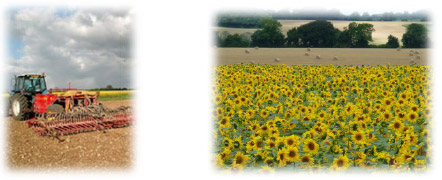
You shouldn't really expect to find barley grains in the seed mixes you buy, however yellowhammers and chaffinches do love barley and we have superb flocks of them here on the farm when there is barley lying in the fields. There are very many poor quality wild bird seed mixes available, especially supplied by shops and garden centres. These have a high % of wheat and maize in them – used as relatively cheap bulking agents. If you do feed a mixed seed which contains a lot of wheat or maize, you will find that you will be inundated with larger birds such as pigeons, doves and pheasant (if you are near open countryside) and jays, rooks and jackdaws. These bigger birds will dominate feeding areas and will prevent the smaller garden birds from feeding. Other cheap 'filler' ingredients such as split peas and beans as well as bits of dog biscuit are also found in cheaper bird seed mixes. None of these should be fed to garden birds so avoid purchasing these mixes.
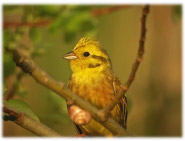 |
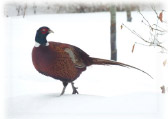 |
High quality seed mixes will contain a good % of nutritious, high oil seeds like black sunflowers and sunflower hearts, peanut granules, oil seed rape and niger seed. Interestingly, although naked oats are a cereal grain, they do have a very high oil content – and this probably explains why they are so popular. For general, day to day feeding, seed mixes which contain a good blend of the oil seeds and cereals grains will provide daily sustenance. During periods of high stress, such as extreme cold weather or feeding youngsters, garden birds will benefit from being offered a diet, higher in oil seeds- be they straights, such as sunflower seeds or within a high energy seed mix.
The type of feeders you use will, to some extent be determined by the food you are offering. Most commonly, seed mixes and sunflower seeds are offered in hanging tube feeders. The common garden birds which use this type of feeder are Greenfinches, Goldfinches, Chaffinches, Sparrows, Blue Tits, Great Tits, Coal Tits and Siskin. Finches will typically stay at a feeder perch while feeding, whereas Tits will usually repeatedly visit the feeder and take away individual seeds to eat them in a nearby tree or bush.
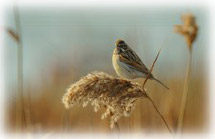 |
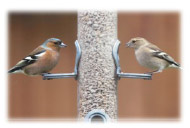 |
Niger seed and Thistle seed are two fine small seeds loved by Goldfinches and Siskin. Thistle seed comes from the Teasle plant which grows wild in the UK. It is a biennial plant and it is therefore difficult to cultivate and harvest large quantities, making the teasle/thistle seed incredibly expensive to buy. You can often spot goldfinches feeding on wild teasle plants at roadsides. Niger seed is a more affordable alternative. It is a tiny, fine black seed, related to the sunflower seed, and grows in Ethiopia as the Ramtil plant. It has to be fed from a special niger seed feeder, which has tiny 'slit' feeding holes instead of normal seed ports. Seed ports would allow Niger seed to pour out onto the ground. Goldfinches and Siskin have extremely pointed bills which allows them to access the Niger seed in the special feeders. Whilst other finches, like Greenfinches, Bullfinches etc. do enjoy the taste of niger seed, the size and shape of their bills makes accessing the niger feeders nigh impossible!
Peanuts on the other hand require a steel mesh feeder since the mesh prevents garden birds such as Nuthatches and Coal Tits taking whole peanuts and hoarding them! The mesh offers a clinging area and means that birds like Great Spotted Woodpeckers, Nuthatches, House Sparrows, Tits and Siskins just peck at the peanuts. A 6mm mesh size is optimal; large enough to prevent beak damage, yet small enough to hold the peanuts back.
Peanuts are rich in fat, and must be 'nil detectable' aflatoxin rated. Aflatoxins are toxins produced by the fungus Aspergillus flavus that can affect peanuts and will be harmful for garden birds if ingested. The fungus develops if peanuts are transported or stored in hot and humid conditions. All the peanuts we supply here at Street End Farm have been rigorously tested to ensure they are 'nil detectable aflatoxin' rated. Please note that salted or dry roasted peanuts are also not suitable for your garden birds.
Soft-food feeders, for seed mixes with a high percentage of peanut granules ( see our Deluxe Robin Crumble) and mealworms, are mainly used by cheeky Robins, but you may find Blackbirds and some Tits recognise something tasty in the dish. Very occasionally a brave Wren or a Pied Wagtail may hop up onto a soft food feeder for some mealworms. These feeders usually have a 'roof' element to keep the rain off and prevent the peanut granules from becoming soggy.
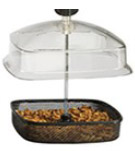
These types of foods cannot be used in tube feeders for this very reason – they get clogged up. Live Mealworms, which are the larvae of the flour beetle (Tenebrio molitor) are 48% protein and 40% fat and can be used to feed birds throughout the year, however it is important that any mealworms fed to birds are fresh. Dead or discoloured mealworms should not be fed since they can cause problems such as Salmonellosis. Feed live mealworms from a shallow, steep sided dish – such as a ramekin dish, if you don't have a bespoke mealworm feeder.
Hanging feeders for suet pellets, suet blocks and fatballs are becoming ever more popular. It is mainly the Tit family which visit the fat feeders, and Long Tailed Tits in particular will arrive in families to feed on tasty fat products.
Again it is important to supply really good quality fat for maximum energy. We recommend that you remove any nylon mesh from fatballs or peanuts since they can trap tits by their legs and woodpeckers by their barbed tongues. Although we do still sell fatballs with mesh, (for customers without fatball feeders), our sales ratio of un- netted to netted is nearly 10:1 – so most customers now chose the safer option for their birds.
Another great way to help feed garden birds like Treecreepers, Firecrests, Great Spotted Woodpeckers etc , is to fill the bark holes in tree trunks with softened suet containing insects, mealworm and peanut granules- delicious!
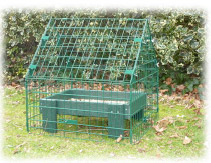 |
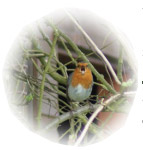 |
For those birds that prefer ground feeding (such as Dunnocks, Blackbirds. Thrushes, Robins and Wrens), there are a variety of options available. The foods they love include black sunflower seeds, pinhead oatmeal, rolled naked oats, soaked sultanas and raisins, mild grated cheese, mealworms, and soft apples, pears, bananas and even grapes. You can simply scatter food on the ground for them, or a range of low level 'table type' ground feeders are available. With both these methods, ground feeder guardians are effective in preventing the larger (and sometimes less welcome) birds like pigeons, jays, magpies, crows, etc from hogging the feeder and eating all the food! It is important when ground feeding to 'feed to demand' and don't have uneaten food left over since this will attract rats. To reduce disease build up, try also to move the feeding area from place to place. A note of caution; raisins and sultanas are nephrotoxic to dogs and cats (can damage their kidneys), so please don't allow them to 'hoover' up the ground feed. And finally, of course, many ground feeding birds will happily land on a bird table they feel safe on as this Treecreeper is showing.

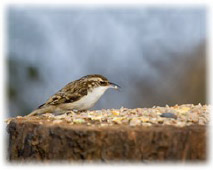
For tips on how to manage feeding birds in the present of problematic squirrels, please see our page on deterring squirrels.
With special thanks to Stephen Baldwin and Pete Berry for photographs
 Back
Back Bird Foods
Bird Foods
 Seed Mixes
Seed Mixes Straight Seeds
Straight Seeds Mealworms & Worms
Mealworms & Worms Chicken Feed
Chicken Feed Duck Food
Duck Food Peanuts & Peanut Butter
Peanuts & Peanut Butter Suet & Fat Balls
Suet & Fat Balls No Mess Bird Seed
No Mess Bird Seed Wheat Free Bird Seed
Wheat Free Bird Seed Sunflower Seeds
Sunflower Seeds Softbill Bird Food
Softbill Bird Food Bulk Bird Seed
Bulk Bird Seed Trial Packs
Trial Packs Pick & Mix
Pick & Mix Mini Pick & Mix
Mini Pick & Mix Birdie Basics: Budget Bird Food
Birdie Basics: Budget Bird Food Food for Small Birds
Food for Small Birds Back
Back Bird Feeders
Bird Feeders
 Seed Feeders
Seed Feeders Peanut Feeders
Peanut Feeders Peanut Butter Feeders
Peanut Butter Feeders Suet & Fat Feeders
Suet & Fat Feeders Window Feeders
Window Feeders Hanging Feeders
Hanging Feeders Feeding Stations
Feeding Stations Ground Feeders
Ground Feeders Easy Clean Feeders
Easy Clean Feeders Bird Tables
Bird Tables Seed Trays
Seed Trays Bird Baths & Drinkers
Bird Baths & Drinkers Feeder Accessories
Feeder Accessories Feeder Hygiene
Feeder Hygiene Squirrel Proof Bird Feeders
Squirrel Proof Bird Feeders For the Kids
For the Kids Niger Seed Feeders
Niger Seed Feeders Mealworm Feeders
Mealworm Feeders Bird Food Storage
Bird Food Storage Fat Ball Feeders
Fat Ball Feeders Tube Feeders
Tube Feeders



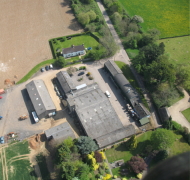 Our Farm
Our Farm
 Tips & Advice
Tips & Advice
Contact Us

